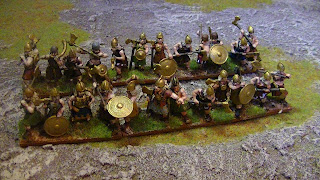Photos of the army:
 |
| The Clan Leaders |
 |
| Photo: ancientcraft.co.uk |
By the costumes of the figurines and their armament, my Army DBA corresponds essentially to the culture of the age of the bronze Nordic but I did not hesitate to exploit the knowledge related to the other cultures that it is for the decors or others.
.
"In the north of Germany, Denmark, Sweden and Norway, the Bronze Age inhabitants produced many beautiful and typical artifacts, such as pairs of lurks discovered in Denmark. Some linguists believe that a proto-Indo-European language was probably introduced in the region around 2000 BC. AD, which eventually became the ancestor of the Germanic languages. This would coincide with the evolution of the Nordic Bronze Age towards the culture of Jastorf (or pre-Roman Iron Age), which was almost certainly Germanic.
This age is subdivided into six periods (from I to VI), according to Oscar Montelius. Period V is already in the Iron Age in other regions." (dixit Wikipedia)
This age is subdivided into six periods (from I to VI), according to Oscar Montelius. Period V is already in the Iron Age in other regions." (dixit Wikipedia)
It seems that a climatic transition occurring towards -2700 is at the origin of the Danish Bronze Age. A warm climate (comparable to that of the present Mediterranean) allowed a strong population growth and favored the yield of the crops: it is known for example that the grape was cultivated in Scandinavia at that time. But a change in climate between -850 and -760 and a marked cooling down to -650 (to which the legend of the Fimbulwinter preceded Ragnarök was attached) seriously degraded the living conditions.
It is probable that this climatic transition of the seventh century BC led the Germanic tribes to the south and central Europe. There were already Scandinavian tribes in eastern Europe; A thousand years later, the numerous Germanic tribes claiming to be of Scandinavian origin (eg Lombards, Burgundians, Goths and Hérules) called Scandinavia (Scandza) the matrix of peoples. The Scandinavian influence in Pomerania and northern Poland from -1300 appears to have been so strong that these two regions are included in the Danish Bronze Age culture.
The prosperous age of the Danish bronze disappears around -450, perhaps because of the subatlantic deterioration of the climate: the Nordic countries then decline millennia. About 700 ap. J. Chr., However, a new civilization (an Iron Age civilization this time) was to be born on these same lands, that of the Vikings (dixit Wikipedia)
I have just come across this very interesting article devoted to a great battle of that remote period. The page is very well tied and consults with pleasure.
The battlefield:
The prosperous age of the Danish bronze disappears around -450, perhaps because of the subatlantic deterioration of the climate: the Nordic countries then decline millennia. About 700 ap. J. Chr., However, a new civilization (an Iron Age civilization this time) was to be born on these same lands, that of the Vikings (dixit Wikipedia)
I have just come across this very interesting article devoted to a great battle of that remote period. The page is very well tied and consults with pleasure.
The battlefield:
" They weren't farmer-soldiers who went out every few years to brawl. These are professional fighters". Thomas Terberger, archaeologist at the Lower Saxony State Service for Cultural Heritage














